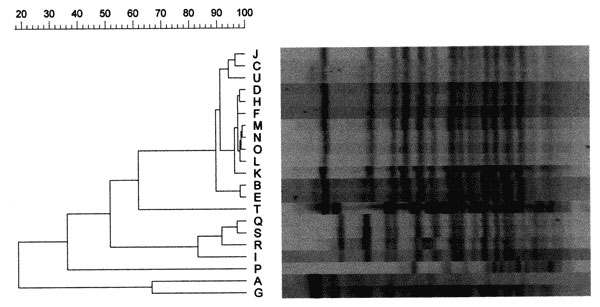Volume 6, Number 1—February 2000
Dispatch
Burkholderia pseudomallei Traced to Water Treatment Plant in Australia
Figure

Figure. Results of pulsed-field gel electrophoresis (PFGE) of clinical and environmental isolates of Burkholderia pseudomallei from western Australia. Molecular typing was performed by electrophoresis of twice-digested 18h XbaI digests of chromosomal DNA from each isolate with a pulse time and ramp of 5.5 to 52 sec from 20h at 200V. Lanes correspond to the following isolates: A,G initial and recurrent infection separated by >12 months in epidemiologically unrelated case in outbreak community; B,C,D,E,F blood culture isolates from each patient in case cluster; H,K duplicates of same isolate from backyard tap water collected during initial investigation; I soil isolate from distant location; J duplicate of clinical isolate corresponding to lane F; L isolate obtained from prechlorination water specimen collected during initial investigation; M ground-level water tank prior to chlorinator; N spray from uppermost aerator tray; O spray from lowermost aerator tray; P root soil around bore main; Q,R,S domesticated animal isolates from same distant location as isolate I; T from potable water at distant location; U late-onset infection in visitor to outbreak community during exposure period. Relatedness of PFGE patterns was measured with Molecular Analyst software (version 1.6, Biorad, Hercules, CA) and showed 90% or better agreement between all clinical isolates in the cluster and most isolates from the potable water supply. Epidemiologically unrelated clinical isolates and nonwater and distant environmental isolates showed no clustering with the above.